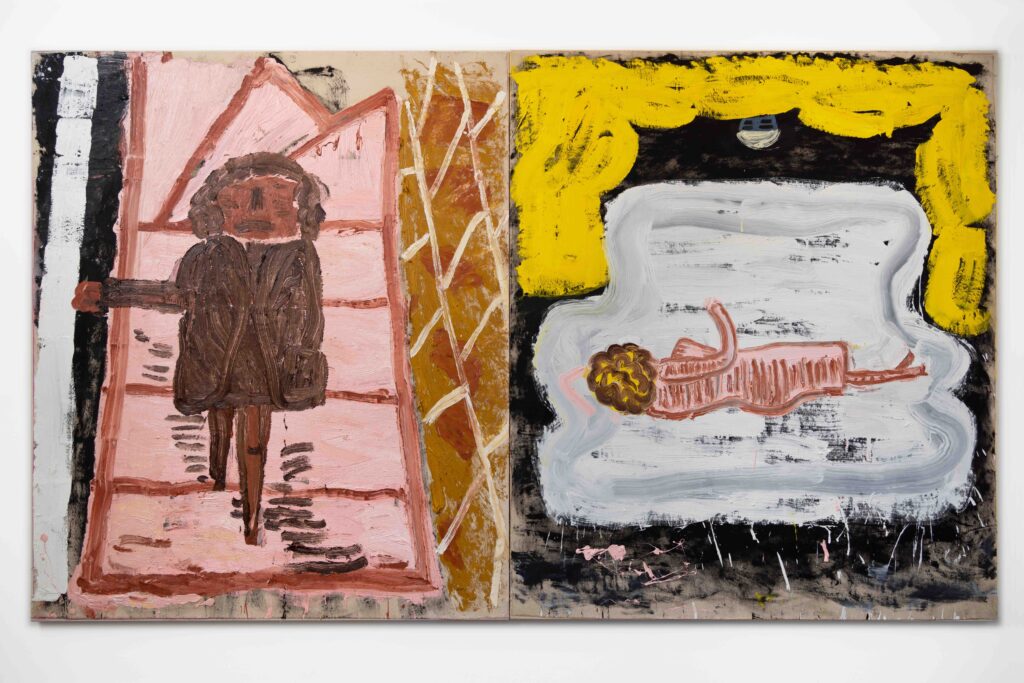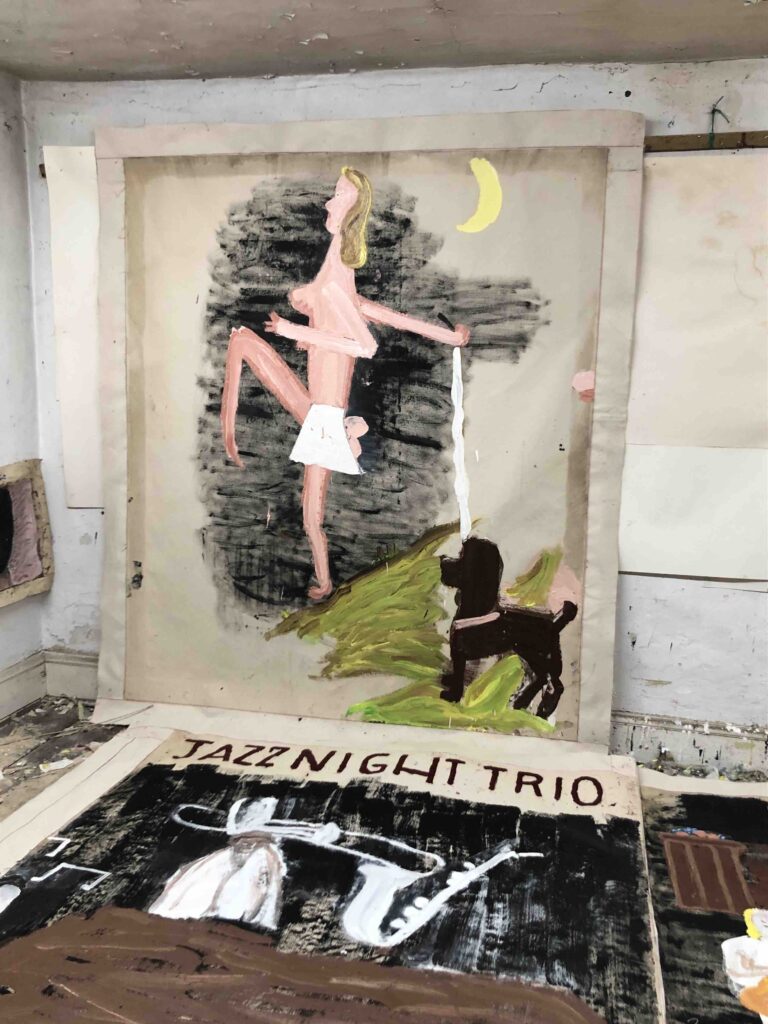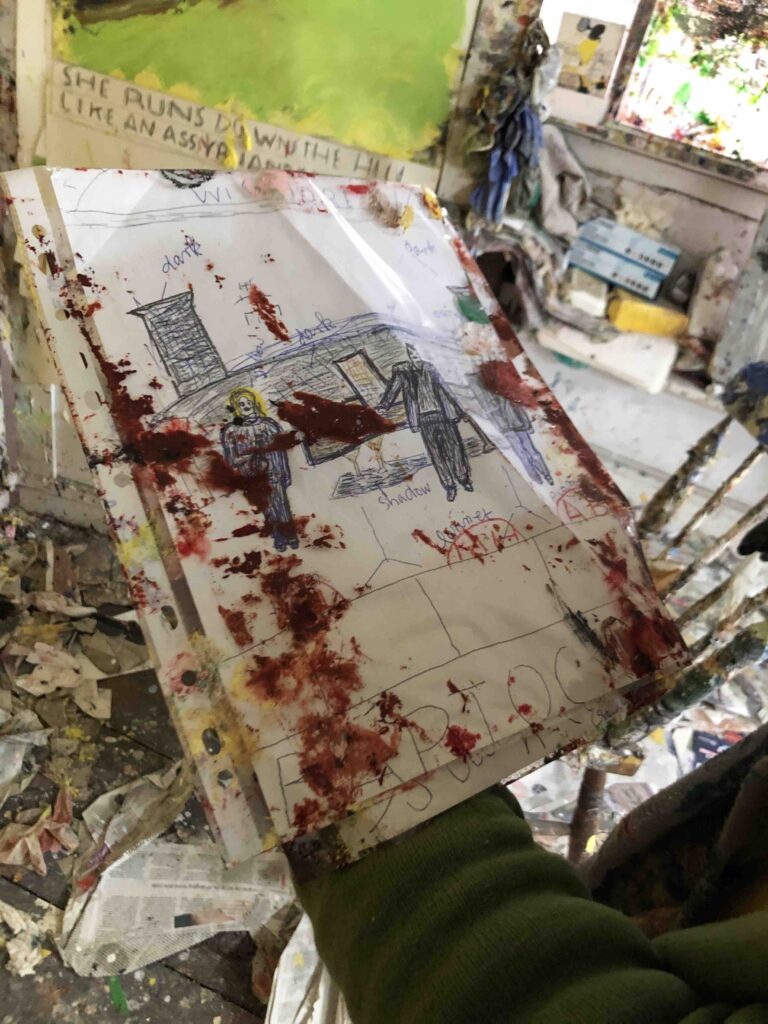Reading Upside Down: A Conversation with Rose Wylie

Rose Wylie, Hold the Right Rail, 2021, oil on canvas in two parts, 184 x 311 cm. Courtesy of the artist and David Zwirner.
Rose Wylie, whose watercolor Two Red Cherries appears on the cover of the Review’s Winter issue, lives in a cottage in Kent, England, that smells of firewood. A treacherous, narrow staircase leads up to a small studio. (“Hold the rail!” Wylie warned me.) Her large, funny, vibrant figurative paintings—made on unprimed, unstretched canvas—cover the walls and floor. When I visited on a recent Saturday afternoon, as Storm Arwen brewed outside, she told me she had spent the first years of her life in India, where her father worked as an engineer. The family moved back to England during the Second World War. Wylie studied at an art school in Kent and then a teacher-training program at Goldsmiths where, at nineteen, she met her husband, the painter Roy Oxlade. She put her own professional ambitions aside to raise their children, channeling her artistic energies, she said, into “soups, jam, clothes, curtains, and Christmas cards.” In her forties, she completed a degree at the Royal College of Art, and worked in relative obscurity until eventually, in her late seventies, her career started to take off, with solo exhibitions at Tate Britain and elsewhere. We talked at her kitchen table, drinking Lapsang tea. The mince pies I’d brought from London had crumbled on the journey, which seemed to delight her.
INTERVIEWER
How did people respond to your work in the early years?
WYLIE
I got very little response. I was considered a mother and a wife, married to an artist who was more prominent, and so whatever I did didn’t get a lot of recognition. That made me want to do it more, and more defiantly. I just thought, Bugger this! It was an impetus.
INTERVIEWER
How did you develop your style?
WYLIE
Look at that painting behind the dining table. That was one of my early ones, and it could just as well have been done yesterday. It’s peculiar to me when critics say that my paintings are naive or childish. I choose to work in a way I find exciting. “Naive” would be making unformed judgements, with no intellectual framework. Why is it childish, just because it doesn’t happen to look like a da Vinci or a Rembrandt?
INTERVIEWER
Why did you choose to make such big paintings?
WYLIE
I think it was a reaction against having learned to paint on a small easel—or perhaps against the idea that, unlike a male artist, a woman should be happy to do a little picture on the kitchen table. It was a sign of belief in what I did. Sometimes an artist will invent a constraint or difficulty to make his work less slick or more powerful, more grounded in reality—I didn’t have to do that. The difficulty was already there. I’d be in the shed in the winter, in a howling gale, wearing a big coat, sizing up these huge canvases, trying to staple them to the walls. Sometimes the canvases would blow off and wrap themselves around me.
INTERVIEWER
Where do you think your self-belief came from?
WYLIE
My mother was born in 1885, and esteem was allocated to the sons, and after that it was given by age. I was the youngest of seven, and a girl, so I had no position. Some people are born with prime time. I didn’t have that. I made my own games. I didn’t expect to be taken to places for amusement, or given treats. That was a great freedom. I just thought, Well, if I don’t do things my own way, then there’s no hope.
INTERVIEWER
Was it difficult to be married to a painter in the years when you weren’t painting yourself?
WYLIE
It was okay because I read all the time—Dostoyevsky and Chekhov, Mallarmé, Proust, Flaubert, Stendhal, Balzac. Roy and I would go to see shows, and artists would come to visit us. I wasn’t actually putting the brush on the canvas, but I’ve always done a bit of drawing, and I would draw and paint with the children. And I thought my husband was great. We were huge mates. He was dynamic, moody, attractive, funny. I’d do the meals—Roy liked small quantities of food, beautifully presented—but I would also make my own arrangements. I’m used to doing my own thing as well as the other person’s. When I was little, four or five, I learned to read upside down from looking at the book my brother was holding. He always had the book the right way up, so he could only read that way. I could do both.
INTERVIEWER
Did you and your husband have very different ways of working?
WYLIE
Roy was very ordered. I called him a good Bauhaus boy—he was all about form following function. His driving force was rationality whereas mine was a more female intelligence. I sometimes think of that artist who made casts from piss holes in the snow—Helen Chadwick. The man’s is a deep hole, very focused; the woman’s is more scattered and covers more ground. That was like us. Roy was Plato and I was Aristotle. He didn’t like imperfection. I don’t mind imperfection at all, only I don’t call it imperfection—I call it “wearing out” or “it’s got a stain on it” or “it’s falling apart.” Like your mince pie. Roy was always trying to find the ideal subject. I saw subjects everywhere. You use what you’ve got. It could be a crack in the floor, a fingernail, a gooseberry cutting. You know when you clip the tops off, and you have a little pile of tops and tails? I used to think they were stunning.
INTERVIEWER
Have you always made work from observation?
WYLIE
Yes. I maintain that figuration is more difficult than abstraction. People tell me I’m just being controversial, but figuration can be so bad and so distorted, so simpering or too elegant. With abstraction you haven’t quite got those problems. Maybe that is the problem of abstraction—that you haven’t got the problems.
You see these twigs out here? I’ve drawn little birds that sit on those twigs, from underneath. That’s a japonica. It’s related to the quince. The fruit are coral-colored, and there were thirty-seven of them on the ground this year. Never before have I had any. They were like golden apples, Aphrodite stuff. When I make a painting, I observe, but I also transform. You’re observing that they are this color, this shape, this size. They look like this, they feel like this, they smell like this. And then you try to put those things together in a painting.
Recently I’ve been painting a woman I saw running down the hill with her dog on a leash behind her. She was running with her knees right up, and leaning back because of the hill, and she formed such a strong image in my mind. She reminded me of an Assyrian sculpture. The first painting I did of her, I didn’t have the leg right, so I did another one.
INTERVIEWER
What are you thinking about while you paint?
WYLIE
Not much. Sometimes I speak to myself. I say, “Get it off, get it off.” Or “Scrape it off, get rid of it.” Or “Put it back.” I swear quite a bit.
INTERVIEWER
What kind of swearing?
WYLIE
I usually say “Fuck!”—because something has gone wrong, and I think, Now it’s horrible, I hate it! It was alright before, why didn’t I fucking leave it alone?
INTERVIEWER
How long is a painting session?
WYLIE
It’s so variable. Sometimes I’ll go up to my studio and do something in ten minutes and come down again. On other days I’ll go into the studio at about ten or half-past ten, and then miss lunch and go on till three, maybe have a late lunch and go on straight through the evening. Or I’ll have some supper and a glass of wine and then go back to the studio and think, Shit, it’s not right, I can’t leave it like that! And then I’ll try to get it right, and work until three in the morning, and it’ll go even more wrong. Some people say, “You must be having a whale of a time doing just what you want to do,” but it’s not like that. You’re always frightened to start—you don’t want to because it’s too difficult. It’s much easier to look out of the window or read a book. But then, when you’re actually in it, you escape from everything. You escape from climate change, people dying of famine, cows dropping dead. I hate the whole business of what’s happening in the world. My politics are green. We should eat local stuff, carrots and swedes. Not cherries from Washington—how obscene.
INTERVIEWER
Tell me about the cherries in the painting we used on the cover of the Winter issue. Where did they come from?
WYLIE
There were a lot of wild cherries growing at the top of the garden, very dark red. I think they’re completely beautiful, cherries. They made me think of those sixteenth-century Spanish still life paintings. I like the way they hang in doubles. If you look at the painting, it’s like two breasts with large nipples.
INTERVIEWER
I saw that you had recently painted your cat, Pete. Did the pandemic affect what you painted or how you worked?
WYLIE
This is a highly intelligent cat. Watch him. Do you want supper, Pete? Did you see? He understands the word. Sometimes he jumps up onto my shoulder, and he puts one paw on one side and another paw on the other side, and he puts his arms around me. I know cats are affectionate, but this one is extraordinary.
As to the pandemic, I’m often here by myself so in fact there was very little difference. The only problem was that at one point my assistants couldn’t come to collect my paintings, so I would just staple one canvas on top of another on the wall. Having a piece of work superimposed onto another unrelated one like that led to something new, where I started to make paintings that had abrupt changes of image on the same canvas. Eventually my assistants came over wearing gloves and masks to collect the canvases. I left them little diagrams to show them what to do with each one. I actually liked those drawings. They were part of the pandemic and they became part of the work.
INTERVIEWER
How do you feel when a painting leaves your studio?
WYLIE
I think, Well, thank heavens that’s done. I always want my paintings to go into a museum. That is what all artists want. Although private collections are good, too. That gives you money. Fuck it, my paint bills are huge.
Emily Stokes is the editor of The Paris Review.
Copyright
© The Paris Review




